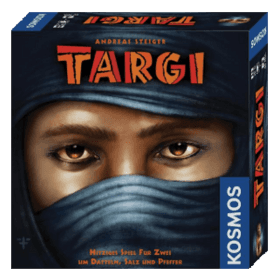Targi
 I Targi er du en adelig leder af en ørkenstamme, og dit mål er at have den største stamme i slutningen af spillet.
I Targi er du en adelig leder af en ørkenstamme, og dit mål er at have den største stamme i slutningen af spillet.
For at opnå målet, skal du handle med lokale Varer (som dadler og salt) og importerede Varer (som peber). Disse Varer gør det muligt for dig at få guld og fordele som vil få din familie til at trives.
Men ørkenen er et forræderisk sted: røvere og konkurrerende familier kæmper om de samme ressourcer!
Antal spillere: 2
Spillængde: 20 mn
Kompleksitet: 3 / 5
Spil Targi og 1194 andre spil online.
Ingen download nødvendig - spil direkte fra din webbrowser.
Med dine venner og tusindvis af spillere fra hele verden.
Gratis.

Spil Targi og 1194 andre spil online.
Ingen download nødvendig - spil direkte fra din webbrowser.
Med dine venner og tusindvis af spillere fra hele verden.
Gratis.

Spilsammenfatning
Each round of play has the following stages:
1. Players take turns playing their three "targi" (meeples) on the border cards. Targi may not be placed in the same row or column as your opponent's targi.
2. Place up to 2 "tribal markers" in the middle of the game board at the intersection of the rows/columns of your targi.
3. You may then activate the cards under each of your pieces. These cards may give you more goods, or they may let you spend your goods to purchase special cards to place in your personal tableau.
You may only hold 3 gold and 10 goods total between rounds.
Phases of Each Round
1. Move the robber one space forward
In the first round, the robber is placed on the Noble space. At the start of subsequent rounds, move the robber one space along the track clockwise. When the robber reaches a corner, a raid takes place and players will lose resources:
- - Raid 1: Lose 1 good or 1 victory point
- - Raid 2: Lose 2 goods or 1 victory point
- - Raid 3: Lose 3 goods or 2 victory points
- - Raid 4: Lose 1 gold or 3 victory points
If a player does not have enough resources to pay the robber at all, their opponent receives the victory points that would have been lost to the robber. After a raid, the next round begins immediately.
2. Place meeples
Beginning with the starting player, players take turns placing their meeples along the track until all meeples have been placed. The cards on which meeples are placed indicate actions available to the player during the round.
Meeples may not be placed:
- - where the robber is
- - where another meeple is
- - on the corner raid spaces
- - on a space directly opposite from an opponent's meeple (along the opposite track)
3. Place tribe markers
Each player places their tribe markers where the lines of sight of their meeples cross within the centre of the playing field. In most cases there will be two intersections and therefore two markers will be placed. However, if a player has placed two of their meeples opposite one another, there will only be one intersection, and they may only place one tribe marker. The cards on which a player's tribe markers are placed indicate actions available to them during the round.
4. Actions
The first player plays all the actions allowed by their meeples and tribe markers before the next player begins. They are free to decide the order in which each action is played. However, each action must be completed before starting another. A player may also choose not to carry out an action. When a player has used an action from the track, they retrieve their meeple from the card. The card remains as part of the track.
After using actions from cards in the middle of the playing field, the player retrieves their tribe marker, and the used card is replaced by one of the other sort. When using a resource card, the player collects the corresponding token(s), discards the card, and replaces it with a tribe card face down. When using a tribe card, the player decides what to do with it, and then replaces it with a resource card face down.
With tribe cards, a player must decide between:
- a. playing it by paying its cost and then adding it to their display
- b. holding it in their hand
- c. discarding it
Only one tribe card may be held by each player at a time. When holding a tribe card, further tribe cards drawn that are not immediately played must be discarded. To be able to play or discard a tribe card in hand, players must use the Noble space (not available in the first round). Playing a tribe card from the hand using the Noble space still involves paying its cost.
5. Reveal new cards and change starting player
After both players have carried out their actions, all resource and tribe cards in the middle of the playing field are turned face up. The starting player amulet is passed to change the starting player. Begin a new round with the robber moving one space foward.
Additional Rules
Tribe cards
The tribe cards are divided into five types with the following symbols: wells, camels, oases, Targia, and tents.
Players play tribe cards by paying their cost and then using them to build a personal display of three rows of four cards each. Rows are formed from left to right. A row does not have to be finished before starting a new one and players may build upon more than one row at a time.
Cards played remain in their place for the whole game.
If a player completes a row in which all four cards have the same symbol, they will receive 4 victory points at the end of the game. If they complete a row of cards with four different symbols, they will receive 2 victory points. Rows with less than four cards and rows of four that do not meet the above conditions yield no victory points.
The cost to play the tribe cards is indicated at the top right of each card. When a slash appears in the cost, players may choose what to pay between the options. The number of victory points associated with each card is at the bottom right in the form of silver crosses. Tribe cards played may award one-time bonuses, provide a permanent special ability, or have an endgame effect. A player may make use of a card's benefit immediately after adding it to their display.
Border cards
Caravan: Reveal the top card from the resource deck and receive whatever resource token(s) are depicted. Discard the resource card.
Fata Morgana: The player may move one of their tribe markers to another card in the middle that is unoccupied.
Silversmith: Trade 2 identical goods for 1 victory point, 4 identical goods for 3 victory points, 1 gold for 2 victory points, or 2 gold for 4 victory points. Only one exchange is allowed each time this action is played.
Trader: Players may exchange 3 of the same goods for 1 gold, or 2 identical goods for 1 other good. Players may exchange as many times as they are able.
Tribal Expansion: Reveal the top card from the tribe cards deck. Either pay the cost to play it, hang onto it (if not already holding a card), or discard it.
Note: The Raid spaces and the Noble space are explained in phase 1 and phase 4 above.
Resource cards
Resource cards may grant players 1 or 2 goods, 1 gold, or 1 victory point. If all three goods are depicted separated by slashes, the player receives one of their choice.
Resource limits
The number of goods and gold that can be carried over into the next round is limited. After completing all the actions of a round, players that have more than 10 goods or 3 gold must return the excess to the supply. They can decide which specific goods to return. Before the end of a round, however, a player may have more than this limit, to spend on tribe cards, or to be exchanged at the Trader or Silversmith spaces.
End and Scoring
The game ends when either:
- • The robber reaches the 4th raid space, completing a full lap of the board, or
- • A player fills their tableau by playing their 12th tribe card.
If the robber reaches the 4th raid space, the raid occurs and players lose resources before the game ends.
If it is the starting player who ends the game, the other player will finish their turn.
Players add up all their victory points:
- • Victory point tokens
- • Silver crosses on tribe cards in display
- • Bonuses on tribe cards in display if any
- • 4 points for each completed row in the display where all the symbols match
- • 2 points for each completed row in the display with four different symbols
The player with the most points wins. If there is a tie, the player with the most gold wins. If there is still a tie, the player with the most goods wins. If there is still a tie, the game is a draw.
Notes
The supply of goods is unlimited. If there are not enough tokens representing dates, salt, or pepper, the player notes which good they have on a piece of paper.
If the deck of resource cards runs out, shuffle the discard pile to form a new draw pile.

